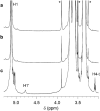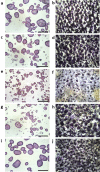Amylose starch with no detectable branching developed through DNA-free CRISPR-Cas9 mediated mutagenesis of two starch branching enzymes in potato
- PMID: 33619312
- PMCID: PMC7900246
- DOI: 10.1038/s41598-021-83462-z
Amylose starch with no detectable branching developed through DNA-free CRISPR-Cas9 mediated mutagenesis of two starch branching enzymes in potato
Abstract
DNA-free genome editing was used to induce mutations in one or two branching enzyme genes (Sbe) in tetraploid potato to develop starch with an increased amylose ratio and elongated amylopectin chains. By using ribonucleoprotein (RNP) transfection of potato protoplasts, a mutation frequency up to 72% was achieved. The large variation of mutations was grouped as follows: Group 1 lines with all alleles of Sbe1 mutated, Group 2 lines with all alleles of Sbe1 as well as two to three alleles of Sbe2 mutated and Group 3 lines having all alleles of both genes mutated. Starch from lines in Group 3 was found to be essentially free of amylopectin with no detectable branching and a chain length (CL) distribution where not only the major amylopectin fraction but also the shortest amylose chains were lost. Surprisingly, the starch still formed granules in a low-ordered crystalline structure. Starch from lines of Group 2 had an increased CL with a higher proportion of intermediate-sized chains, an altered granule phenotype but a crystalline structure in the granules similar to wild-type starch. Minor changes in CL could also be detected for the Group 1 starches when studied at a higher resolution.
Conflict of interest statement
The authors declare no competing interests.
Figures







References
-
- Nadakuduti SS, Starker CG, Voytas DF, Buell CR, Douches DS. Genome Editing in Potato with CRISPR/Cas9. In: Qi Y, editor. Plant Genome Editing with CRISPR Systems. Methods in Molecular Biology. New York: Humana Press; 2019. - PubMed
-
- Birch PRJ, et al. Crops that feed the world 8: potato—are the trends of increased global production sustainable? Food Secur. 2012;4:477–508. doi: 10.1007/s12571-012-0220-1. - DOI
Publication types
MeSH terms
Substances
LinkOut - more resources
Full Text Sources
Other Literature Sources

